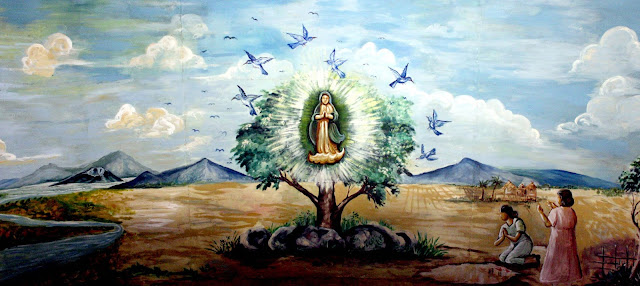El Ecce Homo and Virgen dela Cotta de Cebu - The Unsung Gifts of Ferdinand Magellan
 |
| The gifts of Ferdinand Magellan (From the left): Virgen de la Cotta, Santo Niño de Cebu, El Ecce Homo de Cebu |
These two images were hidden for some time and later rediscovered separately and enjoyed much devotion for centuries until the Second World War came that signaled the abrupt obscurity of the devotions of these two important venerated images in Philippine history that the majority of Filipinos never knew.
 |
| El Ecce Homo de Cebu |
The image of El Ecce Homo de Cebu is a bust image of Christ in his suffering, His head tilted to the side, while his eyes were looking with a sad expression. The image sports the traditional Tres Potencias and sometimes, the Crown of thorns.
The original image of the Ecce Homo was brought by Ferdinand Magellan together with the two images in 1521 as gifts to Rajah Humabon and Hara Humamay who were later baptized as Carlos and Juana. History was silent on what had happened to the images after Magellan was slayed in the Battle of Mactan yet years later, the image of the Ecce Homo was found on August 20, 1572, at the burial site of Rajah Humabon and it was enshrined at the Basilica Minore de Santo Niño de Cebu afterward. Since the rediscovery and enthronement of the image, numerous miracles were reported through the devotion to Christ in His suffering image, and His feast day was celebrated every August 20th to commemorate the founding of the image.
However, when the Second World War erupted, the image was said to be kept for safety, and years later, it was brought to Manila in 1965 when the Augustinian fathers were celebrating the 400th year of Christianization of the Philippines that this image was transferred to Manila and stayed there for decades which at that time, the Augustinian Fathers' lone main headquarters was in Intramuros, Manila. The Augustinians later established a new and separate province of the Santo Niño de Cebu which is independent of the original Intramuros and whatever was in Manila belonged there and in Cebu, it's to the new province. After forty-six years the image returned to its home in Cebu on August 20, 2011. Today, the image is currently enthroned to his own altar at the Basilica Minore de Santo Niño de Cebu and efforts are being made to restore the devotion to the suffering Christ that he enjoyed before the Second World War.
 |
| Virgen de la Cotta of Cebu |
The petite image of Virgen de la Cotta of Cebu is also one of the three holy images that Magellan gave to a ruling couple of Cebu. The image of the Virgin is that of a typical Madonna and Child where the Child Jesus is resting in the arms of the Blessed Virgin Mary and the Virgin in turn sweetly looked at her Son resting.
The image of "Birhen sa Cota sa Sugbo" was found floating inside a well located in Fort San Pedro, Cebu, around the years 1572-1575. The image is made in the Flemish style of carving. The venerated image was enshrined in Cota San Pedro and it gained many devotees since then. The waters from the well were also said to have miraculous properties that due to the cures attributed to the Virgin, she was given the name "Nuestra Senora de los Remedios". Her feast day was then celebrated every December 18.
In the mid-1900s, the image was later transferred to Cebu Cathedral where a chapel was built to house the venerated image. Over the years Cebuanos developed a loving and special devotion to the Virgin. However, during the Second World War, the Cathedral was bombed yet there were several unverified stories that are circulating for years that the image was spared and the whereabouts of this miraculous image are unknown. Two replacement images were later commissioned to revive and maintain the devotion to the Virgin of Remedies, one in the Cathedral of Cebu, and the other in Fort San Pedro.
These two venerable images have a very significant historical value in our country by playing a significant role in the Christianization of our country for centuries and these should not be forgotten by many. As the Catholic Philippines is preparing for the 500th anniversary of the introduction of the faith in 2021 and it is about time to rediscover our history so that our present generation could have a glimpse of the past and appreciate it.
References:
Aviado, Lutgarda, (1972), Madonnas of the Philippines, Manlapaz Press, Quezon City.
Mayol, Ador Vincent S. (2012), ‘Ecce Homo’ comes home to Cebu, Retrieved from https://cebudailynews.wordpress.com/2011/08/21/%E2%80%98ecce-homo%E2%80%99-comes-home-to-cebu/.
Sanchez, Francisco (1904). La Virgen Maria Venerada en sus Imagenes Filipinas, Manila: Imp. De Santos y Bernal.
*Special thanks to Mr. Louie Nacorda.





Comments
Post a Comment